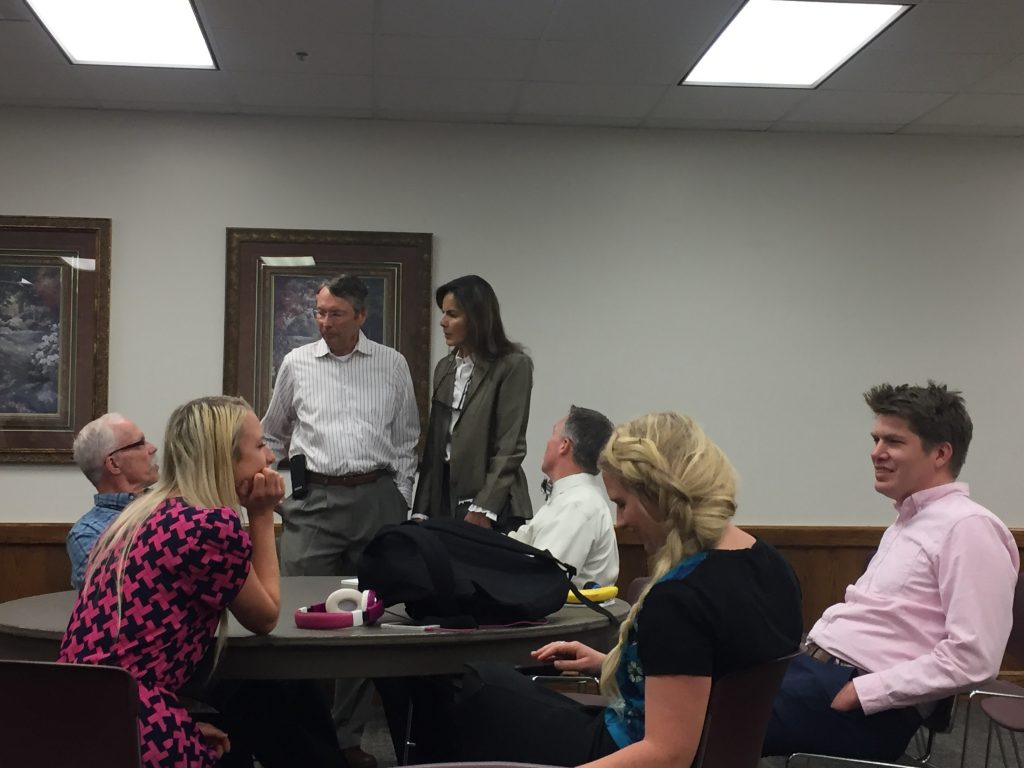
Provo City Council members discussed parking, housing, recycling and public transportation with students, faculty members and local residents at the Policy Discussion Lunch in the Wilkinson Student Center earlier this week.
The council members usually have policy discussion lunches at the City Hall. This discussion was brought to BYU to increase student involvement, according to council member Kim Santiago.
City council members Santiago, Gary Winterton, Dave Knecht, Kay Van Buren, Dave Harding and Dave Sewell attended the meeting.
Kim Santiago’s intern and BYU student Collyn Mosquito, led the discussion by asking the council members questions students had submitted. Then, the council let attendees voice concerns and ask questions.
The following includes questions asked along with answers given by council members.
How can students contribute to local policy meetings?
Sewell said students can contribute by getting to know the council member who represents them — either in person, by phone or by email. Sewell said getting one council member involved can lead to action on students’ concerns.
“Find a council member who will engage with you on your issue,” Sewell said.
Harding encouraged students to engage with Provo’s local government, even if they only live in Provo for a few years. He said current students both benefit and suffer from the engagement — or lack of engagement — of previous BYU students.
“Do your part and make life better for the students beyond,” Harding said.
Santiago said she once worked with a father who emailed her about getting safety regulations for trampoline bounce-houses. This father’s child had an accident at a local bounce-house and is now paralyzed. Santiago connected with hospitals, firemen, surgeons and gymnasts in order to get appropriate regulations passed. These safety regulations are now in effect.
“This all came about from one father, one email,” Santiago said.
Council members encouraged students to participate in committees, sign up for email newsletters and engage in social media to keep in touch with the Provo City Council.
How will housing conditions improve in Provo?
Knecht said housing reports are prepared, reviewed and approved by committees. He suggested students interested in housing zoning join the neighborhood chair’s email list.
Winterton said zoning has been a challenging issue for everyone. He said the implementation of the bus rapid transit will have the biggest impact on future generations.
Harding said the quality of life in Provo is “pretty good,” but the community cannot keep doing the same things if life in Provo is going to continue to improve.
“We need to grow smarter,” Harding said. “To me, (bus rapid transit) is just the first step towards a smarter, more sustainable mode of public transportation.”
Council members asked the attending students what it would take for them to not drive their car in Provo and walk or bike instead.
Students said biking and walking aren’t safe because of poor street lighting and congestion. Students also said riding public transit is too expensive and inconvenient.

Will the fading red paint on the curbs be repainted?
Provo’s curbs are edged with peeling red paint, and a student expressed uncertainty about locations that are off-limits for parking because of this issue. A council member said the city is phasing out the use of red paint and moving toward using parking signs.
The council member also said Provo is in the process of hiring a parking manager, something the city has not had before.
What are Provo’s plans for recycling?
Van Buren said Provo has a recycling system, although it does not have a complete selection of recycling options. He said recycle pick-ups for several types of waste, such as newspaper and glass, are expensive. Council members said local schools have recycle drop-offs, and residents can find the drop-offs online.
Council members said that a map of the city’s recycling drop off locations would be helpful to residents. They also said the privately-owned apartment complexes, where many students live, use private companies for recycling.
What is the city doing to involve minorities, especially Latinos, in the community?
A student said over 10 percent of Provo is Latino, but there is little representation of the Latino community in the city. The student said he feels he is in a “bubble” as a student and is unaware of the needs of minorities.
Santiago said it’s always a struggle to involve any group of people. Santiago said the Council starts by engaging the people they know, and then those people help the community get involved.
Winterton said Mayor Curtis has made “great strides” in addressing the needs of women in Provo.
“Let us know of the needs that are out there,” Winterton said. “Then we can work on those things. We never want to exclude. We want to include.”
Can Provo make bike commuting easier?
Santiago said a bicycle master plan for the city was passed several years ago. This means anytime a road is built or refurbished, it will be created with biking paths and lanes in mind.
“There is an effort to create a more bike-able community in our city,” Santiago said.
Harding said significant efforts are underway to create “complete streets” in Provo. Complete streets are roads with access for cars, bikers and walkers.
Harding said the challenge of this issue is the ability to create the infrastructure.
“If you don’t have the infrastructure, people won’t leave their cars, and if people won’t leave their cars, it’s hard to justify the infrastructure,” Harding said.
Harding suggested those who want to get involved join Provo Bicycle Committee or the Transportation and Mobility Adviser Committee.
“We are looking to make all parts of the city bike-able and walk-able for all of our residents,” Harding said.




